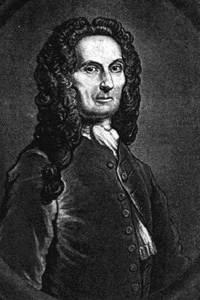de Moivre, Abraham (1667–1754)
Abraham de Moivre was a French-born English mathematician who founded analytical trigonometry and stated what has become known as de Moivre's theorem (see below). He also worked on probability theory and the normal distribution, and was a good friend of Isaac Newton. In 1698 he wrote that the theorem had been known to Newton as early as 1676.
 |
De Moivre's theorem
De Moivre's theorem is a theorem that links complex numbers and trigonometry. It states that for any real number x and any integer n,
(cos x + i sin x)n = cos(nx) + i sin(nx)
By expanding the left hand side and then comparing real and imaginary parts, it is possible to derive useful expressions for cos(nx) and sin(nx) in terms of sin(x) and cos(x). Furthermore, the formula can be used to find explicit expressions for the nth roots of unity: complex numbers z such that zn = 1. It can be derived from (but historically preceded) Euler's identity eix = cos x + i sin x and the exponential law (eix)n = einx.
The bell curve
The bell curve is a means of portraying probability distribution; its main purpose is to show how most features follow natural patterns, hovering around an average occurrence and declining exponentially as they move away from the norm. This, when plotted on a graph, results in a bell shape, referred to as the "de Moivre distribution," after de Moivre, who proposed its formula in 1733.
A century later, in 1833, German mathematician Carl Gauss theorized that, statistically, probabilities would congregate about a norm. His theory was seized upon by ideologists, who wanted to show that harmonies gathered in neat and proper order around a measured, golden mean; they longed for a verifiable ideal to which social, political, and economic aims could aspire. The post-Enlightenment influence of Gauss's idea was huge: large, unpredictable deviations (outliers) are rare and came to be more or less dismissed as enthusiasm for smooth curve of the bell grew. In a world that humanity had begun to manage by means of description, it offered a significant improvement in the ordering of knowledge.


